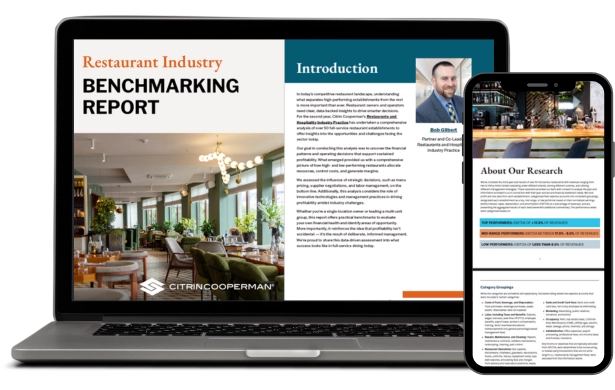Strategic Decisions for Successful Restaurants: Food and Beverage Cost Control
In today’s competitive landscape, understanding what separates high-performing restaurants from the others is more important than ever. Citrin Cooperman’s Restaurants and Hospitality Industry Practice has undertaken a comprehensive analysis of over 50 full-service restaurant establishments and assessed the influence of strategic decisions, such as food and beverage cost control, on the bottom line.
Our analysis shows that most restaurants operators were able to keep their cost of goods sold (COGS) flat at around 25%. Inflation remained relevant in 2024 with food prices increasing approximately 2%. Operators were able to match those increases with menu changes to keep their margins in place. More operators are starting to understand the importance of data and using technology to track their costs by menu item and sales mix.
How the Top Performers Operate
- Top operators track inventory daily or weekly, not just monthly. They use portion control tools (which can be connected to inventory software programs such as MarginEdge) and follow prep schedules based on reasonable sales forecasts. This minimizes shrinkage, overproduction, and food waste.
- Similar to the prior year, several of the top performers in this category had strong brunch and lunch business. Brunch operations can be very profitable due to economical ingredients, ingredient overlap, high table turnover, and high-margin cocktails.
- High performers regularly negotiate with suppliers, leverage contract pricing, and track ingredient costs in real time. They often maintain relationships with multiple vendors to ensure competitive pricing and reduce vulnerability to commodity swings. When measuring the time/effort with obtaining bids prior to placing orders versus the savings, understand that a $10 million establishment that improves its F&B costs from 27% to 23% yields an additional $400,000 to the bottom line.
How the Low Performers Operate
- Low performers often rely on outdated information or perform counts too infrequently. Without tracking waste or spoilage, operators are unable to explain why their food and beverage inventory depletion exceeds their food and beverage sales.
- Lack of consideration for input costs when designing the menu. This results in a lack of coordination between cost strategy and sales efforts. The front of house may not be promoting high-margin items and inadvertently promoting low-margin items.
- Lack of training and accountability: If staff aren't trained or incentivized, portion sizes vary, waste goes unchecked, and no one feels responsible for food costs, leading to high variance and margin erosion.
Trends
Continued inflation, supply chain volatility, and rising commodity prices — especially for proteins and dairy — are driving food costs higher. Additionally, the aluminum and steel tariffs are impacting the cost of beer in aluminum cans, steel kegs, and brewing equipment.
Explore the Restaurant Industry Benchmarking Report

For more insights into the trends and challenges facing restaurants in today’s market, access our 2025 Restaurant Industry Benchmarking Report.
For the second year, Citrin Cooperman analyzed over 50 restaurants to determine the influence of strategic decisions, such as menu pricing, supplier negotiations, and labor management, on the bottom line.
Latest Article Cards

Uncharted No More: Capital Sources in the Independent Sponsor Sector
Read More

Effective Retention Strategies for Advertising Agencies
Read More

Uncharted No More: Deal Sources in the Independent Sponsor Sector
Read More

Strategic Decisions for Successful Restaurants: Occupancy Costs
Read More


